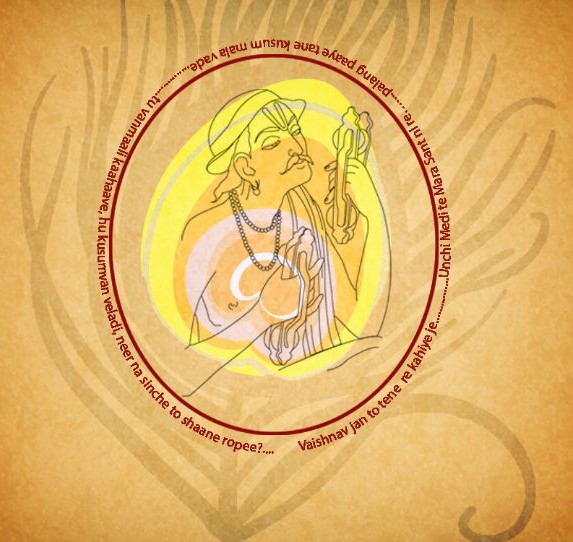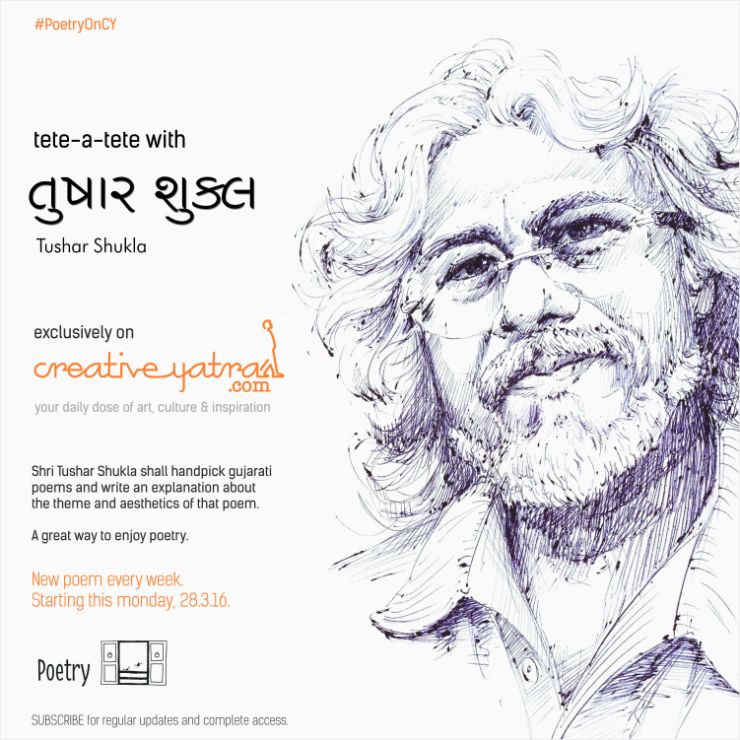Poetry

જળકમળ છાંડી જા રે
‘જળકમળ છાંડી જા રે, બાળા ! સ્વામી અમારો જાગશે;
જાગશે, તને મારશે, મને બાળહત્યા લાગશે. ૧
કહે રે, ‘બાળક ! તું મારગ ભૂલ્યો? કે તારા વેરીએ વળાવિયો?
નિશ્ચે તારો કાળ જ ખૂટ્યો, અહીંયા તે શીદ આવિયો?’ ૨
‘નથી, નાગણ ! હું મારગ ભૂલ્યો, નથી મારા વેરીએ વળાવિયો;
મથુરાનગરીમાં જુગટું રમતાં નાગનું શીશ હું હારિયો.’ ૩
‘રંગે રૂડો, રૂપે પૂરો, દીસંતો કોડીલો કોડામણો;
તારી માતાએ કેટલા જન્મ્યા, તેમાં તું અળખામણો?’ ૪
‘મારી માતાએ બેઉ જન્મ્યા, તેમાં હું નટવર નાનડો;
જગાડ તારા નાગને, મારું નામ કૃષ્ણ કહાનડો.’ ૫
‘લાખ સવાનો મારો હાર આપું, આપું તુજને દોરિયો,
એટલું મારા નાગથી છાનું, આપું રે તુંજને ચોરિયો.’ ૬
‘શું કરું, નાગણ ! હું હાર તારો? શું કરું તારો દોરિયો?
શાને કાજે, નાગણ ! તારે કરવી ઘરમાં ચોરીઓ?’ ૭
ચરણ ચાંપી, મૂછ મરડી, નાગણે નાગ જગાડિયો:
‘ઊઠો રે, બળવંત કોઇ બારણે બાળક આવિયો.’ ૮
બેઉ બળિયા બાથે વળગ્યા, કૃષ્ણે કાળીનાગ નાથિયો;
સહસ્ત્ર ફેણા ફૂંકવે જેમ ગગન ગાજે હાથિયો. ૯
નાગણ સહુ વિલાપ કરે છે નાગને બહુ દુ:ખ આપશે,
મથુરાનગરીમાં લઇં જશે, પછે નાગનું શીશ કાપશે. ૧૦
બેઉ કર જોડીને વીનવે : ‘સ્વામી ! મૂકો અમારા કંથને;
અમો અપરાધી કાંઇ ન સમજ્યાં, ન ઓળખ્યા ભગવંતને.’ ૧૧
થાળ ભરી શગ મોતીએ શ્રી કૃષ્ણને રે વધાવિયા;
નરસૈયાના નાથ પાસેથી નાગણે નાથ છોડાવિયા. ૧૨
Interpretation by Shri Tushar Shukla (in gujarati)
‘ગિરિ તળેટીને કુંડ દામોદર, ત્યાં મહેતાજી ન્હાવા જાય.’
નરસિંહ મહેતાએ પોતાના જીવન વિષે ગાયેલાં પદમાં આ પંક્તિ એમની દિનચર્યા સ્પષ્ટ કરે છે. ગિરનારની તળેટીમાં ઝૂલણા છંદમાં આલેખાયેલા પ્રભાતિયા લલકારતા પસાર થતા નરસિંહ મહેતા આપણા પ્રથમ કવિ-સ્વરકાર છે. Composer Poet! એમના પદમાં રહેલી ગેયતાએ આ પદોને આપણે માટે કંઠોપકંઠ ગવાતાં સાચવી રાખ્યાં. અલબત્ત, પરિણામ સ્વરૂપ એમાં કેટલાક પાઠ ભેદ પણ મળે છે. કેટલાક સુધારા-વધારાય છે. કેટલાક પદ તો અન્ય કવિઓએ અંતિમ કડીમાં ‘ભણે નરસૈંયો’ કે ‘નરસૈંયા ચા સ્વામી’ ઉમેરીને આલેખ્યાં પણ છે. ‘નરસૈંયા ચા સ્વામી’ જોતાં આ કવિના પદ પડોશમાં મહારાષ્ટ્રમાં ય પરિચિત હોવાનું લાગે.
નરસિંહ મહેતાના પદોમાંથી જે ‘વૈષ્ણવજન’નો ગાંધીજીએ અપાર મહિમા કર્યો, જેમ ગીતામાં લક્ષણ ભગવાને ગાયાં એ જ રીતે નરસિંહ મહેતાએ અહીં સજ્જનની પાત્રતાના ધ્યાનદંડ સ્પષ્ટ કર્યાં છે. કૃષ્ણલીલાના આ કવિના અનેક પદ લોકપ્રિય છે. એમાંથી એક પદ છે : જળકમળ છાંડી જાને બાળા.
આ પદ ‘કાલિય મર્દન’ની ઘટનાનું વર્ણન કરે છે. એ કથા જાણીતી જ છે. પણ અહીં આપણને આપણા આ આદિ કવિએ કૃષ્ણના માધ્યમે પર્યાવરણ પ્રીતિનો સંદેશ યાદ કરાવ્યો છે. યમુનાજળને અશુદ્ધ કરતાં તત્વોને ડામવાની વાતમાં જાણે આજના જળપ્રદૂષણની ગંભીર સમસ્યાનો જ ધ્વનિ છે. કાલીનાગ ઝેરી છે. આવા કૈંક ઝેરથી આજે નદીઓનાં નીર પ્રદૂષિત થયાં છે. ત્યારે એને નાથવા કૃષ્ણની જરૂર છે. નરસિંહે ‘નાથવું’ શબ્દ પ્રયોગ કર્યો છે. નાથવું એટલે કાબૂમાં લેવું. ઉદ્યોગોનો નાશ કરવાથી તો નુકશાન જ જશે. માત્ર એમને પ્રદૂષણ ફેલાવવા સંદર્ભે નાથવાની, કાબૂમાં લેવાની જરૂર છે.
આ જ પદને સાધકો પ્રતીકાત્મક રૂપે પણ જુએ છે. જીવનની યમુનામાં, આ દેહમાં વસતા કાલીનાગને ય નાથવાનો છે. ભારતીય તત્વચિંતનમાં શરીરમાં 7 ચક્રોની કલ્પના છે. અને આ ષડ્ચક્ર ભેદન એ સાધકનું લક્ષ્ય છે. મૂલાધારમાં-કુંડલીની એ નાગ છે. એને નાથવાનો સંદર્ભ છે. અને મસ્તિષ્કમાં રહેલ અંતિમ-સહસ્રાધારને સિદ્ધ કરવાનું લક્ષ્ય છે. એ થાય ત્યારે ભીતર એક અનાહત (કશું ય આહત થયા વગર જ જન્મનો નાદ) નાદ સંભળાય છે. એ શ્રી કૃષ્ણની બંસરી છે. જે કાલીનાગને નાથી એની સહસ્રફેણા પર ઉભા રહી નૃત્ય કરતા કરતા બાંસુરી બજાવતા કૃષ્ણ પરમાત્માનું દિવ્ય દર્શન છે.
કોઇપણ સંદર્ભે મુલવતાં, નરસિંહ મહેતાનું આ પદ ભીતર આનંદના ઐશ્વર્ય અજવાળાં કરે છે. ઉત્તમ કવિતાનું એક લક્ષણ એના આવાં અનેક અર્થઘટનની સંભાવના પણ છે.
English Paraphrase by Mihir Gajrawala (based on Shri Tushar Shukla’s interpretation)
Narsinh Mehta is inarguably one of the most significant literary legend from Gujarat. He is one of the first who can be credited as a composer-poet; and it is the inherent rhythmic structure of his compositions that has given them an incomparable place in the folklore of Gujarat. 600 years since he created them, his works are still sung and remembered by thousands every day.
His extremely popular work ‘Vaishnava Jan to’, a favorite of Mahatma Gandhi, is a song that paints a character sketch of a good human. Many of his songs based on ‘Krishna leela’ (incidents from Lord Krishna’s life) are popular, one of them being ‘Jalkamal…..’
The above work ‘Jalkamal chhandi ja ne bala’ is a description of ‘Kaliya Snake trample’ a popular incident from Lord Krishna’s young life. Through this work, it seems the poet is reminding us the value of being harmonious with nature. Today the issue of pollution of Yamuna river, and every other river, with industrial pollutants has reached an urgent point. ‘Kaliya the snake’ is venomous, just like the pollutants that make the river water poisonous; somewhere hidden in this poem is the message to tame and control the pollutants that are harming the rivers. The poet has used the word ‘naathvu’, meaning by to take control and not to destroy. The poem urges us to take control of the factors that are leading to pollution.
Seekers view this verse in a metaphorical light. In the Indian Yogic System, the human body has 7 chakras. These chakras are aligned to the spine of the body, starting from the base of the spine. ‘Kundalini’ the spiritual energy is trapped in the ‘Muladhara’ the root chakra; denoted in texts as a lotus. The purpose of a seeker is to control the ‘muladhara’ and activate the ‘Sahasrara’ (the crown chakra). ‘Kundalini’ in symbolic terms is depicted as a snake. The visual of Lord Krishna dancing atop the ‘Kaali Naag’ (the snake with 1000 heads) is a symbolic depiction of a seeker having activated his ‘crown chakra’; when this happens human consciousness becomes one with existence, and the sound of it is equated with the sound of Lord Krishna’s flute.
This speaks volumes about Narsinh’s unique capability to covert incomprehensible ideas into popular folklore. The mark of a great poem is its potential for multiple interpretations. Whichever way one looks at Narsinh’s poem, it does provide a deep sense of joy to the reader.
Legendary poet from 15th century Gujarat, India.
Know more : https://creativeyatra.com/culture/narsinh-mehta-remembering-the-legend/





